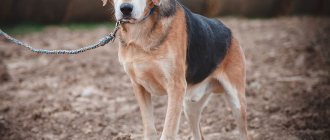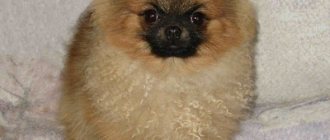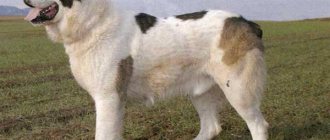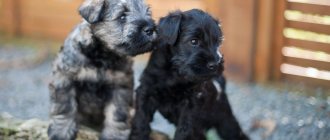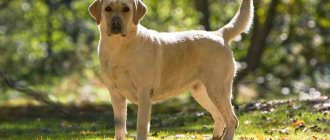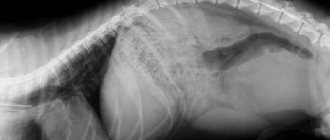Initially, there was an aboriginal Caucasian Shepherd Dog - a breed that arose and developed naturally, under the influence of natural forces and natural selection. After breeders became interested in this breed, it gradually began to turn from an aboriginal breed into a factory breed. In this article we will look at the difference between the “old” and “new” Caucasian Shepherds, find out how many years they live, and describe the main parameters of the standard approved for this breed.
History and modernity
It is generally accepted that Caucasian Shepherds have certain characteristics and have the same structure. These are large dogs of impressive weight, with well-developed muscles, a rough type of body structure and powerful bones. Potential owners are interested in how long these individuals live. Their average lifespan is ten years.
However, there are different types of dogs of this breed in the world, differing depending on the area of breeding. To understand how they developed, we need to go back many years, to the time of the origin of the breed, in order to understand what exactly modern Caucasian Shepherd Dogs are.
Various Caucasian peoples who lived many years ago made human friends out of ancient wild wolf-like dogs. Animals began to serve people, playing the role of guard and protector. And harsh natural conditions eliminated individuals unsuitable for work.
As a result, the aboriginal Caucasian Shepherd Dog appeared - a large, physically developed dog, with thick hair to protect it from a wide variety of weather conditions and capable of living for many years.
Due to living conditions in different areas, the “aboriginals” were divided into two subspecies. The mountain subspecies of dogs was distinguished by its heavy weight, long hair, strong limbs of medium length, and powerful muscles. The steppe subspecies of dogs had short hair, high limbs, a lighter body structure and less weight.
Numerous peoples of the Caucasus tamed Caucasian Shepherd Dogs (Caucasian Wolfhounds) in their own way, according to certain foundations and traditions that existed for many years. Gradually, dogs of this breed were divided into many species that unofficially exist in the world to this day. There are as many peoples as there are species, of which there are several main ones:
- Georgian;
- Armenian;
- Azerbaijani;
- Dagestan.
All types of dogs of this breed have slight differences in weight, body structure, length of limbs and coat.
Gradually, breeders from Russia and other countries became interested in native Caucasian wolfhounds. Breeders took control of the breeding of Caucasian Shepherds, turning the “native” into a factory dog. Work to improve the breed went on for many years.
As a result, the Caucasian Shepherd Dog has undergone some changes, becoming more suitable for the city than for living in the mountains and steppes. Now, due to the influence of the urban environment and cases of unfair breeding, these animals live ten to twelve years, whereas previously they could live much longer.
Not everyone knows that this breed has varieties. The largest dog from the Caucasus - this is what the world called the Caucasian Shepherd Dog, merging all its existing species into one.
In the process of establishing pedigree breeding of Caucasian Shepherd dogs, several standards were adopted. Next we will describe the latest version of the FCI (Federation Cynologique Internationale) standard, approved in 2010.
The Caucasian Shepherd breed standard consists of the following parameters:
- general appearance and important proportions;
- temperament;
- head;
- frame;
- limbs;
- wool cover;
- colors;
- dimensions: height, weight;
- shortcomings and vices.
Average weight and height
In order to find out how much a Caucasian Shepherd dog actually weighs, you need to compare its age, gender; there are several correspondences between age and weight, which determine the development and standard of the animal.
Knowing the weight of the Caucasian Shepherd for all months will help determine how well the owner feeds the dog, whether it has delays in growth, or possible problems with the gastrointestinal tract.
It is important that the main indicators at the lower limits are normal; any minor changes or discrepancies may not be counted at all.
If body weight indicators exceed the limits, it is important to understand how realistic this is; perhaps you simply overfed the dog or did not give it enough physical activity, and the fat layer has increased. Much depends on the nutrition itself, since it should not only be balanced, but also be rich in the content of all useful substances and microelements.
If strong discrepancies and indicators are detected, it is worthwhile to look for the cause; it may be in nutrition, a developmental defect, or non-compliance with standards as a result of breeding marriage.
Up to 2 weeks after birth
The most important and significant stage in the life of a little puppy. The first days and weeks of life, immunity is laid, the entire internal system of the animal is formed, the weight with which it is born is the first indicator of viability and future size.
- The newborn weighs at least 450 grams at the lower limits, at the upper limits 856 grams, this is the largest weight that has been recorded according to the latest data.
If the mass passes along the lower boundary, there is a possibility that this dog will be quite medium or even small in size in the future. The fact is that after birth, babies quickly begin to gain weight, and the smallest of them can catch up with puppies with larger figures.
The same can be said about large individuals - this is far from an indicator, it can either be the most powerful or then add significantly fewer brothers, which will lead to average values.
- In the first 10 days, the animals eat and sleep, move little, their eyes are not yet open, they are completely blind. They begin to fuss only without receiving basic needs - they are cold, they want to eat, they do not lie down comfortably, someone is disturbing them, they feel that they are wet, they feel uncomfortable due to pain.
With a good birth and an average litter, the puppies are completely fed with the mother’s milk, but if the mother is unable to feed the children or there is trouble, the breeder can supplement them himself.
Daily weight gain is from 110 to 210 grams - daily.
Having reached the age of two weeks, they must double their initial weight, or add significantly more, by this age it ranges from 1800 to 3000 kg.
General appearance and important proportions
The world's largest dog from the Caucasus is a large, strong, well-proportioned animal. Her slightly elongated body has a strong bone structure and physically developed muscles. At first glance it is easy to distinguish a male from a female. Males have a large head and pronounced withers. Bitches are smaller and longer.
Ideal proportions: the length of the Caucasian Shepherd's body is a maximum of eight percent greater than its height at the withers. The distance from the ground to the elbow joint is equal to half the height of the animal. A dog's muzzle makes up a third of the length of its skull.
Dogs of this breed must move calmly, freely and confidently, even when trotting. The movements are coordinated, the lines of the croup and withers are at the same level and are in relative calm. The animal pushes off strongly from the ground with its powerful hind legs.
3rd month
Outwardly, at this age, small shepherd dogs become similar to bear cubs. They are still clumsy, but their legs have noticeably elongated, and their heads and chest have become more voluminous.
At three months of age, daily weight gain is 200-400 grams.
By the third month of life, the puppy weighs 18-32 kg, and the height at the withers is 45-49 cm in boys and 43-46 cm in girls. From the age of three months, the shepherd dog begins to develop conditioned reflexes, and this is the time that is considered the most suitable to begin systematic training of the pet.
Temperament
The world's largest dog from the Caucasus has all the necessary protective qualities: poise, confidence, courage, independence, and the ability to make its own decisions at a crucial moment.
The Caucasian Shepherd is infinitely loyal to its owner and his family and is ready to protect its “pack” from enemies until the end of its days. Always hostile towards strangers, but can restrain his impulse on the orders of the owner.
Video "Caucasian Shepherd"
In this video you will hear a description of the Caucasian Shepherd breed.
Recommended Posts
Standard height and weight of the Cane Corso breed by month
Description and content of the hunting border terrier
Weight of a puppy and an adult Labrador by month
Weight and height of a German Shepherd puppy by month
38 best dog breeds for apartments according to reviews from breeders and owners
Description and care of the highly intelligent Border Collie breed
Head
The wedge-shaped shape of the dog's head ends with a wide base. The large and voluminous skull has an almost flat frontal part, which is divided in half by a shallow groove. The bump on the back of the head and the transition from the muzzle to the forehead (stops) are not particularly noticeable. The chewing muscles are well developed.
The large, wide, black nose does not protrude beyond the lines of the muzzle. The nostrils are moderately open.
The dog's voluminous muzzle tapers towards the nose. Its top line is parallel to the line of the forehead. Under the eyes, the animal's muzzle is well filled with well-developed muscles. The shepherd's muzzle ends with a powerful lower jaw and chin. Voluminous lips have distinct black pigmentation.
The standard allows for both scissor and level bites in Caucasian Shepherds. Typically, a complete set of teeth requires the presence of forty-two white teeth that are closely spaced together. Broken, knocked out teeth, missing first premolars (maximum two) are considered normal, but only if these flaws do not interfere with the determination of the bite.
The animal's eyes are of medium size, deep-set, wide and oblique. Black eyelids fit tightly to the eyeballs. Eye color can vary in intensity: from dark brown to hazel. The world's largest Caucasian dog always has a serious and attentive look, assessing the surrounding situation every second.
Small ears in the shape of a triangle hang on cartilage, and their inner part is very close to the dog's head. The ears are quite thick to the touch. Traditionally, they are docked (part of them is cut off). But the standard also allows uncropped ears.
The low-set neck of the animal is of medium length. The neck muscles are well developed. In males, the scruff of the neck is clearly visible.
Frame
The dog's physically well-developed body is quite wide and proportional. The straight line of the back ends in a short, slightly convex loin. The long, voluminous croup of the animal is slightly beveled towards the end (near the beginning of the tail). The voluminous, oval-shaped chest is well developed. The stomach is tightened thanks to developed muscles.
One of the largest dogs in the world, the tail is set high and crescent-shaped. When she is excited, she raises her tail high above her back. When calm, the tip of the tail reaches the hock joint.
Limbs
The forelimbs are perpendicular to the ground and are relatively far apart. Muscles are physically developed. Strong, close-fitting shoulders to the chest, together with wide shoulder blades, form an angle of one hundred degrees. The elbow joints are parallel to the surface and directed straight back. Short pasterns have an almost straight structure.
If you look at the dog from behind, you will see that the hind legs are perpendicular to the ground and are moderately far apart. The clearly visible hock and stifle joints are at an angle of one hundred and fifty degrees. The thighs, shins and metatarsals are well developed physically.
All limbs end in large rounded paws.
Coat
The coat of the Caucasian Shepherd consists of three components: undercoat, guard hair and outer coat.
The undercoat consists of thin, soft-to-touch hairs that resemble down. It performs a warming function. Basically, the undercoat is clearly visible, but can be of different densities, depending on the conditions of detention and the influence of seasonal molting.
The guard coat is thick, straight, and rough to the touch. It is the main part of the coat and is evenly distributed throughout the dog’s body. The largest number of guard hairs is located on the back.
Cover hairs are rare, but distributed throughout the body of the Caucasian Shepherd. There are pores around each hair, the function of which is to saturate the animal’s skin with oxygen.
One of the largest dogs in the world has three types of hair:
- long (up to twelve centimeters, with a mane, feathering on the limbs, “pants” and a well-furred thick tail);
- intermediate (medium length, no fringes or “pants”);
- short (up to seven centimeters, without the presence of a mane, fringe or “pants”).
Brief history of the breed
Caucasian Shepherd Dogs are one of the oldest dog breeds. According to archaeological excavations, the history of the breed goes back more than 2,500 years. The homeland of these dogs is considered to be the territories around the Caucasus range, as well as the steppes of southern Russia.
Dog scientists distinguish two versions of the origin of this dog breed.
The first theory considers the ancestors of Caucasian Shepherd Dogs to be Tibetan Great Danes, which in Ancient China were used in battles and also poisoned wolves.
According to the second version, representatives of the breed originated from dogs that guarded the walls of the ancient state of Urartu, whose territory now includes Azerbaijan, the northwestern part of Iran, Armenia and eastern Turkey.
It is important. Caucasian Shepherd Dogs, according to the classification of the International Canine Federation (hereinafter referred to as the FCI), belong to group 2 “Pinchers and Schnauzers, Molossians, Mountain and Swiss Cattle Dogs” of section 2 “Molossians” of subsection 2.2 “Mountain Dogs”.
Dimensions
It’s not for nothing that Caucasian Shepherds are called one of the largest dogs in the world. The minimum height for males is 68 centimeters, the minimum height for females is 64 centimeters. The minimum weight for males is 50 kilograms, the minimum weight for females is 45 kilograms.
Departing from the standard parameters, let’s consider how much a Caucasian Shepherd puppy weighs at different stages of life, provided that it was properly fed and maintained.
1-3 month. A Caucasian Shepherd puppy is born weighing 600-800 grams. During the first month, the puppy’s weight increases to 200 grams per day, and in the next two months - up to 400 grams per day. One and a half month old puppies are small and compact, while three month old ones look like little bear cubs.
3-6 months. During this period, the puppy's weight should increase approximately three times. Until six months, the chest develops, the puppy grows in height and gradually turns into an adult dog.
6-12 months. During this period, the puppy’s weight increases by only thirty percent. The baby begins to look more and more like an adult. By the age of ten months, the puppy's growth practically stops. Weight gain continues.
12-18 months. The dog's growth stopped, reaching its maximum.
18-36 months. Weight gain continues. By the age of three, the muscle mass of the world's largest Caucasian dog reaches its maximum.
You can find out exactly how much a Caucasian Shepherd puppy weighs at different stages of its life from the following table:
In addition to size, many people want to know how many years dogs of this breed live. With good care, their life can be ten to twelve years.
Extension
At five or six years old the dog begins to age. This primarily manifests itself in physical and mental changes. It becomes more difficult for the animal to move, movements become difficult and slow down. Shortness of breath appears. Extending the life of the pet depends only on the dog owner. An active lifestyle combined with a properly selected diet and timely vaccination is necessary for a shepherd dog. Training and education will have a beneficial effect on the character and obedience of the dog, partially reducing the problems associated with the pet in adolescence and old age.
Proper nutrition
Caucasians are not particularly demanding when it comes to diet. What should you feed your shepherd? The general condition of the animal will depend on the quality of food. For adult shepherd dogs, one daily feeding is enough, while keeping them outside in the winter increases their food intake up to two times. For more comfortable eating and improved digestion, it is recommended to review your diet in favor of light foods. Do not overfeed your dog.
Your pet should be given vitamin complexes and mineral supplements after reaching 8 years of age. Vegetable oil (3-15 ml) per serving will not hurt either Vitamin and mineral supplements will be required if you feed your dog dry food that is less than premium or if he eats an insufficiently balanced natural diet.
Quality care and maintenance
The owner can provide complete comfort to the Caucasian Shepherd by placing the pet on a private property or in an enclosure. It is worth taking care of a booth in advance, where the dog can escape from the heat and cold. Experts strongly do not recommend keeping Caucasians on chains. You should bathe your shepherd two to three times a year, or when dirty.
Teeth brushing is carried out 2 times a month. As needed, the Caucasian Shepherd's ears and eyes are wiped. If the dog cannot clean its claws on asphalt or other hard surfaces, they will need to be trimmed. It is necessary to brush your shepherd twice a week. The daily procedure is carried out only during molting.
To wash a dog of this breed, special detergents are used.
Timely treatment and deworming
Caucasian Shepherds are a hardy dog breed that often does not have health problems and has good immunity.
The first cycle of deworming is carried out at the age of 24-30 days.
In the spring and summer, inspection and cleaning of the ears using a special solution and a cotton pad is carried out more often, since ear mites are a common problem for this breed.
Particularly careful care is required:
- Leather.
- Eyes.
Disadvantages and vices
Any deviation from the standard can be classified as a defect, the severity of which is assessed by the judges depending on their effect on the well-being and behavior of the animal.
Among the disqualifying defects, the following striking examples can be distinguished:
- aggressive or cowardly behavior;
- snack or undershot;
- bobtail;
- non-standard color;
- lack of black color on the nose, lips and eyelids;
- height or weight below the standard minimum;
- disturbances in coordination of movements;
- multi-colored eyes.
What does your dog look like? Tell us about it.
Please share this article with your friends and like it.
From 1 year to 3 years
After one and a half years, the dog’s growth stops, but body weight can continue to increase until the age of three, until the animal reaches the full flowering of its physical development.
According to the breed standard, the average weight of an adult representative of this breed should be from 45 to 50 kg.
But in some very large dogs it can be 90 kg or more.
